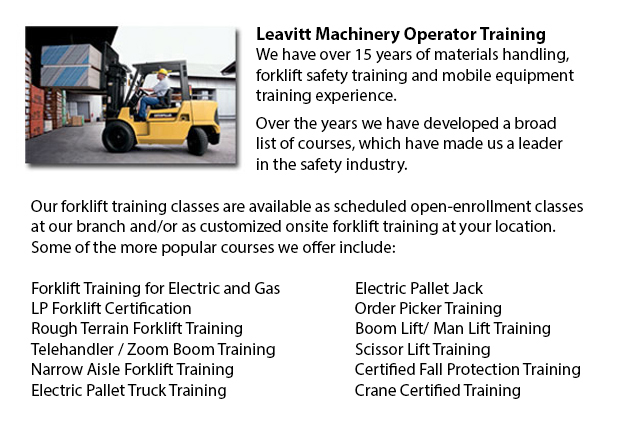
Rough Terrain Forklifts Training Oshawa - There are in reality two categories of forklifts within the production industry, the rough terrain model and the industrial version. Rough terrain lift trucks appeared in the 1940's intended predominantly for use on irregular surfaces, best for lumberyards and building sites, providing lifting muscle when there was no paved surface accessible.
Rough ground forklifts typically employ an internal combustion engine with a battery for power. The engines are able to function on propane, diesel or gas. A number of suppliers are experimenting with rough land lift trucks that make use of vegetable matter and run from ethanol. Substantial pneumatic tires with deep treads distinguish these forklifts to allow them to grab onto the roughest soil type devoid of any misstep or drifting.
The most primitive styles of all terrain forklifts were able to carry weights of up to 1000 lbs, using blades that could slide underneath the item, raise it a tiny bit and then move it to a different location. After a decade on the market, rough terrain forklifts had been given supplementary hauling strength to about 2000 lbs capacity. Telescoping booms were added in the 1960's, allowing them to stack materials a good deal higher than in earlier years. The telescoping design characteristic is a staple of nearly all all terrain forklifts today. Present versions are capable of managing well over 4000 lbs thanks to the continual enhancements through the years. Telescoping ability has additionally improved with some versions achieving a height of 35 feet. Operator safety has also become a focus with many rough terrain forklifts currently built are equipped with an enclosed cab for the driver, versus the older open air seating capacity.
The rough terrain forklifts existing today work just as well on covered floors as on unpaved surfaces. These all terrain forklifts are being marketed for their adaptability permitting establishments to move items from outside the plant to the inside or vice versa.
-
Doosan Forklift
Doosan Forklift Training Oshawa - Doosan Infracore Company Ltd. is an international and intercontinental company that features Defense Industry Products, Industrial Vehicles, Diesel Engines, Automation Systems, Machine Tools and Construction Equipme... More -
Hyster Forklift
Hyster Forklift Training Oshawa - Hyster is an industry leader in the materials handling industry that has been in business for over 80 years. However, it started as a manufacturer of lifting machines and winches. Most of its production was focused... More -
Nissan Forklift
Nissan Forklift Training Oshawa - Nissan prides itself on reaching overall customer fulfillment when their buyer is enjoying one of their numerous trucks, cars or forklifts. Nissan Forklift branch is a wholly owned subsidiary of Nissan Motor Co. Ltd.... More -
Aerial Lifts
Aerial Lift Training Oshawa - Aerial lift trucks can be used to accomplish several unique duties performed in hard to reach aerial places. Many of the odd jobs associated with this kind of lift include performing regular maintenance on structures wit... More -
Pallet Lifts
Pallet Lifts Training Oshawa - A pallet haul is equipment designed principally for moving pallets of differing weights and sizes. They may be used in conjunction with cranes, forklifts and other heavy duty machines as an appendage piece or to be util... More

Forklift Certification Oshawa
TOLL FREE: 1-888-254-6157
Oshawa, Ontario
forkliftcertificationoshawa.com
Email Us
About Us


